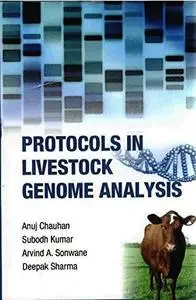Subodh Kumar Et. All Anuj Chauhan, "Protocols in Livestock Genome Analysis"
English | 2014 | pages: 223 | ISBN: 9381226849 | PDF | 4,8 mb
English | 2014 | pages: 223 | ISBN: 9381226849 | PDF | 4,8 mb
The book Protocols in Livestock Genome Analysis Presents the Fundamental principle and detailed protocols of laboratory techniques with an adequate amount of thought been applied towards making it simplistic and effective. The book has been structured into seventeen chapters. It begins with Chapter 1, givingreaders some basic safety and precautions while working in molecular genetics laboratory that is exposed to hazardous agents. Chapter 2, 3 and 4 explains the most basic and fundamental procedures in molecular genetics laboratory i.e. isolation of genomic DNA, plasmid DNA, total RNA which are prerequisite for researchers conducting downstream genetics research like gene amplification or expression. Chapter 5 deals with quantification of DNA and RNA with specific examples. Chapter 6 deals with technique of polymerase chain reaction for amplification of a specific DNA sequences while Chapter 7 focuses on various variants of polymerase chain reaction that have been developed over the years for specific applications. Chapter 8 discusses the reverse transcriptionpolymerase chain reaction which is important prerequisite for gene expression studies and genetic characterization. Chapter 9 describes at length, agarose gel electrophoresis for the separation of nucleic acids and their analysis. Chapter 10describes single strand conformation polymorphism, a technique that is capable of identifying most sequence variations in a single strand of DNA. Chapter 11 details the restriction digestion of DNA molecules by restriction endonucleases. Chapter 12 describes real-time PCR that can detect their accumulation and quantify the number of substrate DNA molecules present in starting sample. Chapter 13 discusses the method of chromatin immunoprecipitation, a very important technique for elucidating the transcriptional regulation of gene expression. Chapter 14 deals with detailed analysis of microsatellite repeat sequences along with statistical tools for data analysis. Chapter 15 explains the very important procedures of DNA ligation, competent cells preparation and transformation involved in cloning of any desired DNA sequence. Chapter 16 describes the set of steps for retrieving QTL & SNP information from online Animal QTL databases. Chapter 17 provides a simple understanding of DNA microarrays. Chapter 18 details the in situ hybridization method for localization of genetic material. Chapter 19 provides the recipe for preparation of buffers and solutions required for conducting various procedures outlined in previous chapters.
My Link



